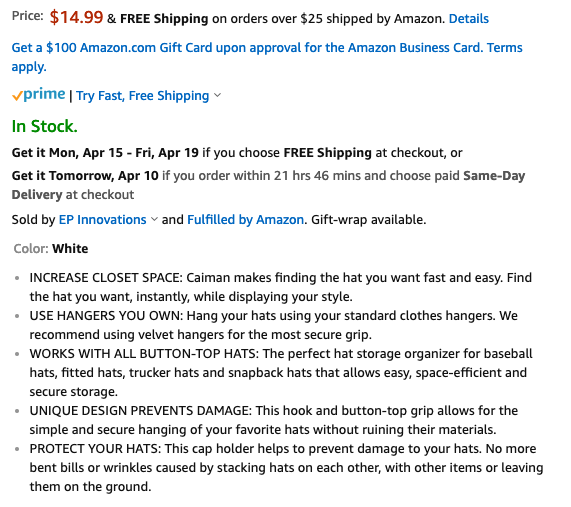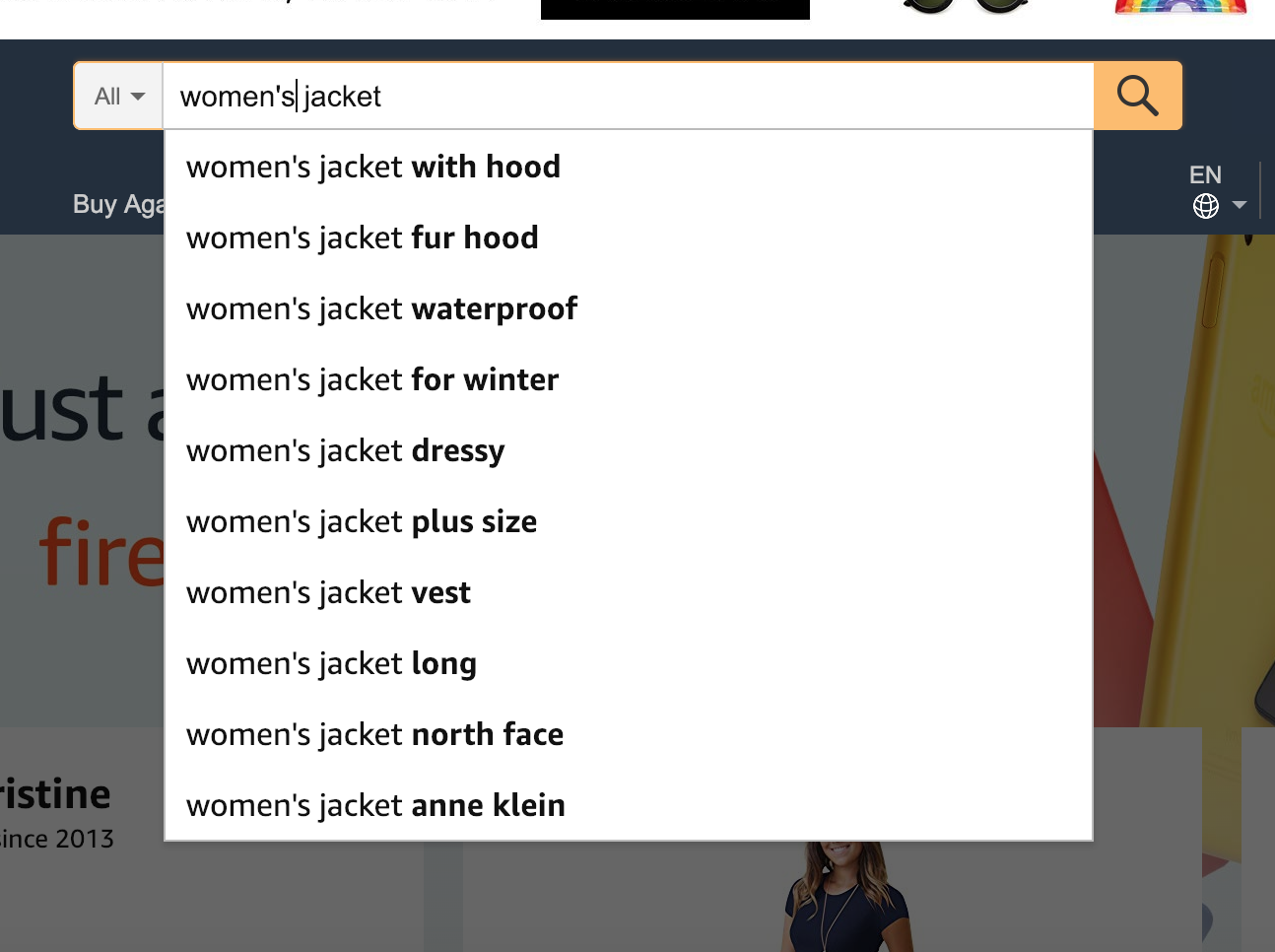Everything You Need to Know About Writing an Amazon Product Listing
Plus A Checklist
Everything You Need to Know About Writing an Amazon Product Listing + A Checklist
While this is good news for Amazon sellers, it does not mean that Amazon will do the work for you when it comes to your product listing. It is your responsibility to create the most competitive listing from a keyword standpoint, while still writing copy that sells your product to your potential customers and truly educates them on the product you’re selling.

This guide will help you sell your products on Amazon by focusing in on how to understand Amazon’s algorithm, how to conduct keyword research and how to write a competitive product listing, followed by an in-depth checklist that will ensure you’ve followed all the necessary steps before you start selling on Amazon.
The Differences Between a Title, Product Description and Search Terms
The Title
The most obvious of the three, the title is your first chance to incorporate your most relevant and effective keywords for your listing. The title is one of the algorithm’s first opportunities to crawl your page for relevant information.
While there are category-specific instructions for every type of listing, which can be found in your Seller Central account, here are Amazon’s General Title Requirements:
Capitalization
- Capitalize the first letter of each word.
- Do not use ALL CAPS.
- Conjunctions (and, or, for) and articles (the, a, an) should not be capitalized.
- Don’t capitalize prepositions with fewer than five letters (in, on, over, with).
Numbers and symbols
- Use numerals (2 instead of two)
- Spell out measurements ( 6 inches not 6″ )
- Don’t use symbols, such as ~ ! * $ ?
- Don’t use Type 1 High ASCII characters (Æ, ©, ô, etc.)
Product Information
- Include the size and color in “child” ASINs (Amazon Standard Identification Number) for variations
- Don’t include price or promotional messages, such as “sale” or “free shipping”
- Don’t use subjective commentary, such as “Hot Item” or “Best Seller”
- Your merchant name for Brand or Manufacturer information should not be included, unless your product is Private Label

Product Listing
Your product listing is where your customers can learn more about your product. Placed to the right, above the fold on desktop devices, this is the first place your customers will look to find information. This is where it’s important to SELL and include benefits-focused information on your listing, as this will help your potential customers understand your product and how it could benefit them.

Search Terms
Did you write the perfect title and product description with the right balance of keywords and sales language, but still have important keywords from your keyword research left over? Add them to your backend search terms section. With a 250 character limit per line, you can include other relevant keywords here. You do not need to include punctuation or repeat words. For example, you do not need to add “women’s fashion jacket” and “men’s fashion jacket”.

What is A9 and What Do I Need to Know About Amazon’s Algorithm?
In order to create an optimized Amazon product description, it’s important to understand Amazon’s A9 algorithm and how to make sure the algorithm favors your listing.
A9 is Amazon’s own internal algorithm for determining listing success and ranking products on the site. Remember, Amazon’s main goal is to sell. So A9 evaluates every listing and places the listing most likely to convert in front of customers based on their search query. It considers:
- Product Title
- Search Terms (your backend keywords)
- Photos
- Conversion Rate
- Relevancy
- Customer Satisfaction
- Order Retention
The last four of those seven factors are a bit harder for the seller to manage, but product title, search terms and photos can be easily updated to optimize your listings.
Before the Writing Begins
Determine Your Audience
Before you begin, you’ll want to consider your customers and your target audience. What do they like? What are their behaviors? How will your product benefit them? What would they like about your product?
Answering these questions will help you begin to form your brand and product messaging, or how you talk about your products and their unique selling proposition (USP).
Analyze Your Competitors
Once you have an understanding of your target audience, you should begin to analyze your competitors.
First, analyze what your competitors are doing both on and off Amazon. On Amazon, see what products are listed when you search for products similar to yours. Take note of how they describe their products and what words or phrases they use. Don’t forget to look at their reviews and examine how customers talk about their products. Think critically about ways to make your product descriptions stand out when compared to your competition’s based on their online content and customer reviews. Do you have a bonus feature that your competitors do not? Be sure to highlight that as soon as possible on your listing.
In addition to Amazon, use Google to search your competitor’s brand name and product name and see what they are doing elsewhere. You should also evaluate the content on their social networks like Facebook, Instagram and even YouTube. See how they talk about their product and how they encourage fans to view their listings on Amazon.
You should also evaluate other online retailers who sell products similar to yours and read what they’ve included in their product listings. Even though you won’t be competing with them directly when someone searches for products on Amazon, there is still much that you could learn from your “off-Amazon” competitors. How are they presenting their products? What are their USPs?
Create Your Keyword List
At this point, you should be ready to begin creating a list of keywords. Start by listing out all potential keywords. Use the knowledge you’ve uncovered through audience and competitor analysis to think of keywords your ideal customers are likely to use, and also consider additional brainstorming tools like a thesaurus to complete your initial keyword list.
Use Amazon’s Autosuggestions
Amazon’s autosuggestions are an easy way to display what customers are looking for and how your competitors are positioning their products on Amazon. For example, if you search “women’s jacket,” Amazon produces a list of some of the top searches related to your query. See which keywords apply to your product and considering using them in your title, product listing or as a search term.

Use the Google Search Bar
Similarly the Google search bar can be a great place to research. For example, if you type “women’s jackets” into the Google search bar and look to the bottom of the page at “Searches related to women’s jackets,” you can find:
- women’s dress jackets
- womens fashion jackets
- womens casual jackets
- jackets mens
- jackets womens
- women’s coats and jackets
- womens winter jackets
Also notice that this search yielded different results than Amazon’s autosuggestions, making both searches helpful when brainstorming keywords.
Conduct Keyword Research
Once you have a list of possible keywords, you can begin to organize and curate your list and prioritize your keywords using a number of keyword tools. Most have free versions available, but if you want an in-depth look at keywords, you should consider investing in one of the paid accounts. Here are examples of three:
SEMrush
The best thing about SEMrush is that it is simple to use and it gets updated regularly. By typing a keyword into their Keyword Magic Tool, you can get over two million keyword ideas, pick the best keywords and save them in Keyword Analyzer. You can even create up to 50 target keyword lists and export your chosen keywords to other SEMrush tools.
Keep in mind, though, that SEMrush is based off of Google results rather than Amazon results. However, the results on both platforms may be similar, so if you are just starting out and are already paying for SEMrush’s keyword tool, starting here is a great option and shouldn’t hurt your listing; there is no need to purchase a separate keyword research tool for Amazon if you are on a tight budget.There are paid Amazon-specific keyword research platforms that will produce Amazon-only results, so if you grow your business on Amazon, you should consider investing in one of them.
Keyword Tool
Keyword Tool will help you automate and speed up your keyword research, as well as better understand what keywords will be most relevant for your listing through search volume data.
SEOChat Keyword Suggest Tool
This tool can search for keywords for Amazon, Google, Bing and YouTube and will provide you with a list of the most popular keyword phrases that all start with your core term. Simply select “Amazon” and conduct your research.
Helium or Jungle Scout
Both of these keyword research tools provide Amazon-specific results. Use them to conduct keyword research, research competitors, evaluate competitors’ reviews, identify trends and more. While they are both powerful tools, they are paid services, so evaluate your budget and needs before purchasing.
Once Your Research is Done
Time to Write
Armed with a solid list of keywords, you can begin to write your product description and product features. Before you begin, familiarize yourself with Amazon’s product page style guide. If you need further help making sure your product listings fit their guidelines, visit the Help Center for Amazon Sellers.
Amazon operates on keywords rather than keyphrases, and you only have to use a keyword once. As we’ve stated before, keyword-stuffing and repetitive keywords will not strengthen your listing. While repetitive keywords will not hurt your listing, you should avoid taking up valuable space with repetitive keywords when possible. Remember, keywords used in your title, product listing and search terms are all weighted equally, so focus on selling your product with the keywords rather than stuffing keywords into your customer-facing copy.
Here are a few things to keep in mind as you write your Amazon product descriptions to ensure they convert:
- Most importantly, incorporate your keywords.
- Use competitor research to establish and address customer pain points in your copy.
- Put the most important information in the title.
- Focus on the benefits in the product description bullets.
- Remember, any keywords you can’t fit in the title or description can be added to the search terms on the backend, so don’t worry about fitting everything into the title or description.
- Depending on the category, between 150-200 characters is ideal for the bullets in the features section. Any additional information you can’t fit here can be added to or expanded upon in the product description section.
Your Amazon Product Listing Checklist
If you write or rewrite your product listing, use this checklist to make sure you end up with a strong listing:
- I have determined the audience for my product
- I have determined and analyzed my competitors, meaning:
- I have read their listings and gleaned any relevant keywords
- I have read their customer reviews and established customer pain points that I can address in my listing
- I have evaluated how they drive customers to their Amazon listing through avenues like a website, paid ads, or organic online content like social media
- I have reviewed other “off-Amazon” competitors for the same information listed above
- Based on my competitor research, I have created a list of potential keywords
- Using my list of potential keywords, I have also researched other keywords with Amazon’s autosuggestions, Google’s search bar, thesaurus, etc.
- I have used tools like SEMrush, Keyword Tool, SEOChat Keyword Suggest Tool and other platforms to rank keywords
- My keywords are listed in a spreadsheet so I can note when a keyword has been used in my listing
- I have written my title with the strongest description of my product and addressed customer pain points if applicable
- I have written my benefits-focused product listing with information listed in order of importance
- Any keywords not used have been added to my search terms on the backend
- I have proofread my copy for any typos, grammatical errors, etc.
